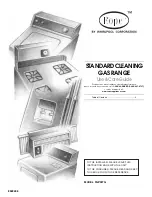
8
Broiling
Broiling uses direct radiant heat to cook food. Changing the
temperature when broiling allows more precise control. The lower
the temperature, the slower the cooking. Thicker cuts and
unevenly shaped pieces of meat, fish and poultry may cook
better at lower broiling temperatures.
■
For best results, use a broiler pan and grid. They are
designed to drain juices and help avoid spatter and smoke.
If you would like to purchase a broiler pan, one may be
ordered. See “Assistance or Service” section to order. Ask for
Part Number 4396923.
■
For proper draining, do not cover the grid with aluminum foil.
The bottom of the pan may be lined with aluminum foil for
easier cleaning.
■
Trim excess fat to reduce spattering. Slit the remaining fat on
the edges to avoid curling.
■
Pull out oven rack to stop position before turning or removing
food. Use tongs to turn food to avoid the loss of juices. Very
thin cuts of fish, poultry or meat may not need to be turned.
■
After broiling, remove the pan from the oven when removing
the food. Drippings will bake onto the pan if left in the heated
oven, making cleaning more difficult.
Before broiling, position rack according to the Broiling Chart. It is
not necessary to preheat the oven before putting food in unless
recommended in the recipe.
To Broil:
1. Position food on grid in the broiler pan then place it in the
center of the oven rack.
2. Close the door.
3. Push in and turn oven control knob to BROIL.
4. After broiling, turn the oven control knob to OFF.
BROILING CHART
For best results, place food 3" (7 cm) or more from the broil
element. Times are guidelines only and may need to be adjusted
for individual foods and tastes. Recommended rack positions are
numbered from the bottom (1) to the top (5). For diagram, see the
“Positioning Racks and Bakeware” section.
RANGE CARE
General Cleaning
IMPORTANT: Before cleaning, make sure all controls are off and
the oven and cooktop are cool. Always follow label instructions
on cleaning products.
Soap, water and a soft cloth or sponge are suggested first unless
otherwise noted.
EXTERIOR PORCELAIN ENAMEL SURFACES
Food spills containing acids, such as vinegar and tomato, should
be cleaned as soon as the entire range is cool. These spills may
affect the finish.
Cleaning Method:
■
Glass cleaner, mild liquid cleaner or nonabrasive scrubbing
pad:
Gently clean around the model and serial number plate
because scrubbing may remove numbers.
■
All-Purpose Appliance Cleaner Part Number 31682 (not
included):
See “Assistance or Service” section to order.
COOKTOP CONTROLS
To avoid damage to the cooktop controls, do not use steel wool,
abrasive cleansers or oven cleaner.
To avoid damage, do not soak knobs.
When replacing knobs, make sure knobs are in the OFF position.
On some models, do not remove seals under knobs.
Cleaning Method:
■
Warm, soapy water:
Pull knobs straight away from control panel to remove.
FOOD
RACK
POSITION
COOK TIME
(in minutes)
Side 1 Side 2
Steak
1" (2.5 cm) thick
medium rare
medium
well-done
4
4
4
14-15
15-16
18-19
7-8
8-9
9-10
Ground meat patties
³₄
" (2 cm) thick
well-done
4
13-14
7-8
Pork chops
1" (2.5 cm) thick
4
20-22
10-11
Ham slice, precooked
¹₂
" (1.25 cm) thick
4
8-10
4-5
Frankfurters
4
5-7
3-4
Lamb chops
1" (2.5 cm) thick
4
14-17
8-9
Chicken
bone-in pieces
boneless breasts
3
4
17-20
11-16
17-20
11-16
Fish Fillets
¹₄
-
¹₂
" (0.6-1.25 cm) thick
Fish Steaks
³₄
-1" (2-2.5 cm) thick
4
4
8-10
16-18
4-5
8-9









































